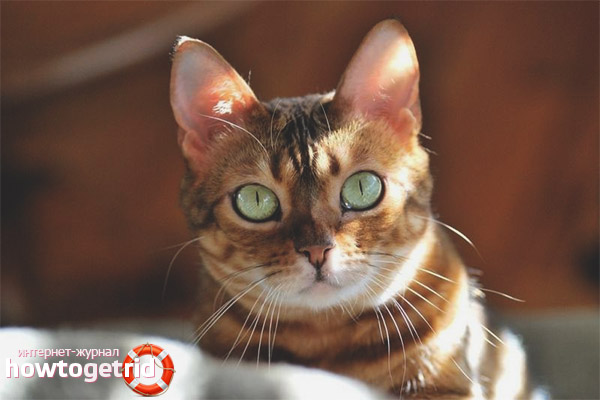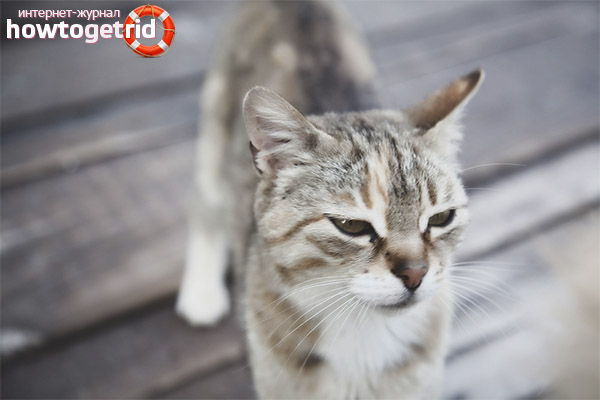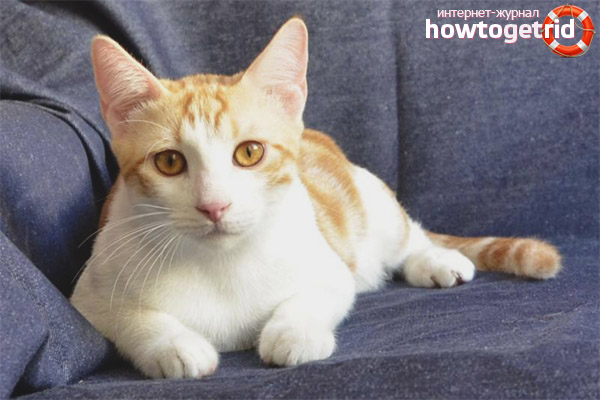The content of the article
- 1 How did the Anatolian cat breed appear?
- 2 Description of Anatolian cat
- 3 Nature and behavior
- 4 Host relationship
- 5 What you need to know for proper care and maintenance of the breed
- 6 Anatolian cat health
- 7 What to feed
- 8 The attitude of the animal to strangers
- 9 Breeding Anatolian cats
- 10 How much is such a kitten
- 11 How to understand that you are buying a healthy kitten?
- 12 Video: Anatolian cat (Turkish Shorthair)
More recently, such a breed began to enjoy great popularity. This breed has existed for more than a dozen years, but got its fame right now. Such cats do not like loneliness, they are smart, they like to play. The animal eats well and has excellent health.
How did the Anatolian cat breed appear?
This is an ancient breed. From many studies, we can say that these cats were one of the first to be tamed. The breed of animals was formed in nature, there were no various experiments and artificial breeding.
The ancestors of the Anatolian cat lived in Eastern Anatolia, today it is Turkey. Today, such a representative of a pet can be found not only in Russia.
The first time this cat breed was brought to the exhibition in Germany back in 1995. This was done by employees of the University of Vienna. Three animals were brought to this exhibition, their coat was white and each eye was a different color. This breed of cats has a short hair, we can say that the animals are short-haired. They attracted the attention of breeders from Germany and Holland. The breed received its recognition in 2000.
Description of Anatolian cat
- The size of this animal is small, closer to average. Their weight can be from three to seven kilograms. Usually a cat is a couple pounds heavier than a cat. The appearance of a cat will also be significantly larger than that of a cat. The muscles are well developed, the seals of this breed are stocky. Kittens appear large.
- The body structure of this breed of cats is strong and muscular. Straight back, sternum wider compared to the pelvic bone. Massive neck. The length of the limbs and tail is average. The paws are round in shape.
- As for the head, it is medium in size, with a large chin. Anatolian cats have slanting eyes, they are large and oval. Usually the eyes are the same color, but cats that have a white color have eyes of different colors.
- The ears themselves are large, have a wide base, and their tips are rounded. Fluffy inside. They are located on the head high, do not bend, stand straight. On the outer edge there is a groove of the sink.
- Fur seals of this breed have short hair. It does not let water through, but rather repels it. The villi are thin, but silky to the touch and slightly tough. Cats can be of different colors. Their coloring is not always monophonic, you can often find the breed of Anatolian cats in the color of bicolor, tricolor or tabby. The tail of the animal will always differ in color from the body and head. It will be a little darker.
Nature and behavior
A feature of such cats is activity, sociability and curiosity. They are very playful, especially in childhood, over time their character remains soft, but already restrained. Any toy to the animal will be a joy, especially if it rustles. Anatolian seals love water, are very calm about swimming and play with water.
If such an animal lives in a family where there are many people, then it chooses a pet for itself and communicates with only one member of the family. Their communication is manifested in facial expressions, movements, gestures and even sounds. Sometimes you can notice how they frown, as if expressing their displeasure.
Cats of this breed do not meow like others, their sounds are more like tweets.Therefore, having such a cat at home, while listening to music, it may seem that the animal makes sounds to the beat of the music.
The intelligence of cats is high, animals understand what a person says, learn quickly, can remember the name of some things and objects, distinguish intonations in a human voice. They understand the rules and commands, remember them, and also execute.
The animal knows its place, quickly accustomed to its toilet. It can carry out light teams. He can be taught to call one of the family members. If the animal is bothering something, then the cat can explain it to the owner. She will be able to show the place where she needs to sit. In the case of some kind of disorder, for example, they forgot to shut off the water, or the water boils on the stove, the cat will voice or even glance to the side, will show its alarm.
Host relationship
The Anatolian cat breed is unique, because the animals are very friendly and very fond of people. At the same time, breeders warn that because of the restlessness that is inherent in cats of this breed, such animals are not for fans of silence. Therefore, if you prefer peace and impeccable order in the house, then you better pay attention to another breed. Older people are definitely looking for a better pet with a more relaxed character.
What you need to know for proper care and maintenance of the breed
This breed is not whimsical in its care. They take care of themselves. The only way the owner can help them is to comb out the hair so that it gets into the stomach as little as possible, but not constantly, but only when the animal sheds.
Cats are rarely bathed, but their ears are constantly cleaned. Once every three days, the cat should clean his ears. To get rid of pollution use a cotton swab and a special tool. Sometimes the animal rubbed his eyes.
Is it worth trimming claws? It all depends on the owner himself, how he decides. The animal is quite active and can cause damage to furniture. If the animal came to you at an early age, then it is worth it to be accustomed to a claw sharpener, and then the furniture will remain intact. Such cats can be both domestic and can go for a walk along the street. But, if a cat walks along the street, there are many dangers, and without claws he will not always be able to avoid them, for example, climb a tree.
Anatolian cat health

The health of these cats is strong, it was formed in natural conditions. It is not exposed to genetic diseases, as animals are bred in an non-artificial way. A cat can get common diseases, like any animal. Due to malnutrition, stones may appear, there may be a difficult birth or infection. It’s easy to pick up an infection for them, they are curious animals and like to study the street. To prevent this from happening, you need to vaccinate the cat and glisten in time, just after each walk, look at the coat for ticks and fleas.
What to feed
For such cats it is better to use natural products. Their appetite is good, but, despite this, they do not grow fat. This is due to good metabolism and their constant activity.
Cats are not particularly picky about food, I eat many products. They love fresh and boiled meat, fish, offal, eggs. Sour-milk products can be safely added to their diet. They are good for cottage cheese and kefir. If the cat is not neutered, then dry food and special canned food for animals are added to its diet.
When the kitten is still very small, he is given dairy products. Previously, a cat should try them, if she does not like the treat - she will not allow her baby to eat such food. Kittens eat often. At three months, their diet becomes 3-4 times a day.
The attitude of the animal to strangers
With strangers, cats and cats of this amazing breed behave in a friendly and affable manner, and you should not expect excessive affection from them. Turkish cats give their love only to their beloved owner.
Breeding Anatolian cats
Cats mature for mating as early as 7–9 months; in cats, this period begins later in the year. But the mating of cats should occur only after the complete physical maturation of the body and the readiness of the animal for the appearance of babies occur. In a cat, such a period begins no earlier than three years. It is best to knit cats at the age of four.
Those planning to breed cats should know that a pregnant cat walks for about 65 days. Kittens appear weighing 100 grams. Typically, kittens are born from two to four. With normal development, a kitten gains from 120 to 150 grams per week. When kittens appear, not only the cat, but also the cat is engaged in the upbringing. Parents take care of kittens for up to five months.
How much is such a kitten
You can buy a kitten from the age of eight weeks. There are few nurseries around the world that breed Anatolian cats. Kittens come to our country from Europe. Often they are brought to exhibitions in Greece, Turkey and Germany. You need to buy a kitten of this breed only on a special nursery website so as not to get caught by scammers.
The animal is sold with a pedigree and costs from 3,000 to 25,000 rubles.
How to understand that you are buying a healthy kitten?
At eight weeks, the kitten eats the same food as the mother, his diet is formed. To determine the health of a kitten, you need to pay attention to the following:
- A healthy kitten is one with white teeth and a light pink sky.
- The ears are clean, not damaged, wounds, scratches, crusts are absent.
- The eyes are clean, not watery.
- You need to try the belly of a kitten. It should be soft and the animal should react normally to touch - this will be a sign that it does not have a sensation of pain.
- The back and tail without growth, the coat is soft.
- The pads on the legs are soft and silky.
- It’s worth looking under the tail, if it’s clean and there are no signs of upset, it means that the cat has no digestive problems.
- If the cat sneezed, and discharge appeared - a viral infection.
- If the animal coughs - problems with the bronchi.
Video: Anatolian cat (Turkish Shorthair)












Submit